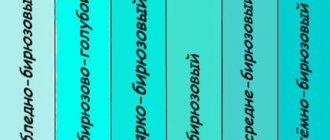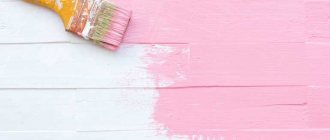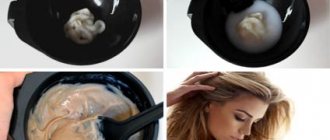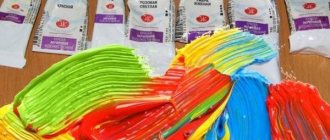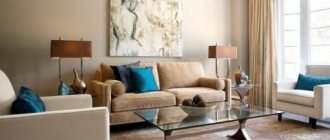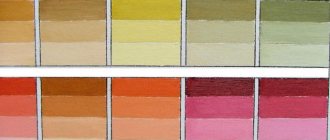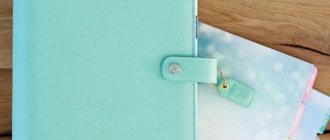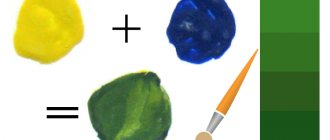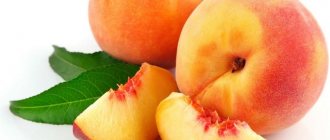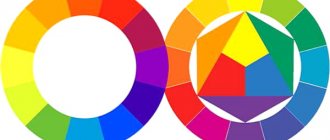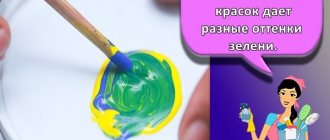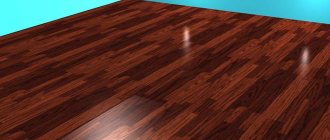Author: Anastasia Isakova · Published 05/29/2017 · Updated 05/29/2017
Anyone who is familiar with the basics of painting should know that there are certain rules for mixing paint. The idea is simple - having only 3 basic colors (yellow, blue and red) you can get the rest of the shades without purchasing additional funds. By combining you can get any result. This is an important skill for an artist. But what if you don’t have any of the main shades? How easy is it to get yellow?
Homemade polish using clear base and eye shadow
You will love the matte look of this nail polish. It's easy to make and apply, and dries much faster than regular store-bought ones. You can adjust the amount of shadow according to your desired shade and apply it like regular nail polish. Add a little more shadow for a rich color and less if you want a lighter shade.
Read also: Why the thermos stopped keeping warm
- Dry eye shadow – 1 cosmetic jar x 5 grams.
- Transparent nail polish – 1 bottle x 10 milliliters.
Color combinations
Briefly about combinations: there are only two ways to obtain the desired shade. The artist needs a special circle, but for the maximum palette there should always be a base at hand. Having basic models in hand, a combination creates brown, green, orange, etc. Everything is easy here. But how to get yellow colors by mixing others?
Getting yellow
How to make yellow? It is worth mentioning that you cannot obtain any of the primary colors by mixing their derivatives. This is the base; there are no other options for obtaining it except buying it in the store. All you can do is create the desired result by diluting the composition with different paints that are similar in palette.
Tinting acrylic paints
The disadvantage of self-tinting is the complete lack of options for repeating the shade needed for the job. Sometimes this problem is solved by using a large number of compounds.
Before getting pink paint, use information on mixture consumption from the manufacturer as a basis. Each dye has its own specific consumption, and the manufacturer indicates this data. Then the surface area is multiplied by the flow rate and 10% is added to the result.
Experts recommend mixing dyes in one container. If you work with different containers, there is a risk of getting different colors even with the most accurate calculations. Therefore, there is no need to risk money and paint; the price for good dyes is quite high.
How to make yellow from gel polish paints
Manicure specialists call yellow a harmful color because it tends to not lie smoothly, leaving noticeable streaks, and does not dry well. Much depends on the quality of the material.
It is possible to make yellow from paints of such a complex chemical composition. By mixing primary and secondary colors of gel polish, then secondary and tertiary, you can create absolutely any shade.
Read also: Black hair tonics
You can make a bright yellow sunny shade like this:
- Place a base yellow tone on the palette.
- Drop a little red.
- Mix gently until a homogeneous mixture is obtained.
- Add a little primary yellow to the resulting secondary orange color.
- To stir thoroughly.
- Apply the shade to the sample (imitation nail).
- Keep under an ultraviolet lamp at a temperature of 48 degrees until completely dry (about 1 minute).
Proportions – 9:1 (yellow + orange); 9:1 (orange + yellow). During the mixing process, a low-quality composition may bubble, so you need to stir carefully and evenly.
Shades of yellow
Shades of this color scheme are actively used in painting. It’s impossible to make it at home in a classic way, but you can create a rich, bright tone. It will echo orange. To create it you will need:
- Place the base on the palette;
- Add a few drops of bright red;
- Add a couple drops of brown;
- Dilute with white until desired shade is obtained.
In production, various shades are created by mixing colors in strict proportions. At home, you can only get yellow color from paints experimentally. Approximate proportions could be as follows:
- Dirty yellow comes out by mixing green and orange in equal parts on the palette.
- If you dilute the base with a drop of red or brown, you get a nice golden hue. The main thing is not to overdo it with brown.
- A bright sunny color comes from a base tone and a mixture of white and red in equal parts. For 4 parts of the base you need to take 2 parts of red and white.
- By adding orange, you can create an interesting version of the tone with an apricot tint, closer to straw.
- Light bronze is created by introducing a small portion of brown into the base paint.
Acid yellow, which artists call lemon yellow, is created by mixing a base with pure green paint. You can lighten it by adding white.
How yellow paints are made
Naples yellow (antimony acid lead with some lead oxide) is the lightest of all yellows. An oil mixture of greenish and reddish tones is prepared. Rubbing with an iron spatula makes it darker. Dries slowly. Cadmium . This is cadmium sulfide. Commercial - may contain some free sulfur and some other substances harmful to color constancy. The circumstances under which the precipitate forms affect the hue or tone of the cadmium; There are 3 or 4 different tones available, ranging from lemon yellow to orange. Lemon yellow is not permanent enough. Cadmium is a very strong K, that is, when mixed with others, it controls the tone resulting from the mixture. It came into use in painting only in the middle of this century. Serves in oil painting and watercolor. If cadmium sulfide enters the human body, it can have a strong toxic effect. Yellow ultramarine (chromate barite). Zinc yellow (zinc chromate). Chromium (lead chromate) is also on K.'s list of products sold for painting, but they are fragile, some by themselves, others in mixtures. Indian yellow , a transparent paint, is one of the most permanent paints of organic origin; it is brought from Tibet to Calcutta and from there to Europe; The exact method of preparation is unknown. Oil and watercolor K.; very light. Gummigut . — Organic yellow watercolor, very transparent paint, poisonous. Ochers necessary for K. are considered yellow, although their color is impure and dim; their color comes from iron oxides, which comprise about 1/4 of them. Light ocher (Ocre clair, jaune, Lichter, Ocker, Yellow, Ocher), the color is impure yellow. Golden ocher (Ocre d'or, Gold Ocker), darker than the previous one, but with a yellow-golden tint. Dark ocher (Ocre foncé, Dunkel Ocker) is almost brown. Stream ocher (Ocre de ru - abbreviated ruisseau - stream). Ochers come in different shades, depending on location; Each country has its own ocher, but they are usually not given local names, although Italian ocher is named. A very long rinsing before washing the paints in oil is necessary to improve their earthy yellow color. Mars of two or three shades, a kind of artificial ocher, more transparent than natural ocher. According to the method of preparation, K is very expensive. The yellow ones also include Aureolin Strontian yellow Platinum yellow (Strontion Yellow, Platin Yellow - both English preparations), which, as fickle, we will limit ourselves to mentioning. Brown: Sienna or Sienna earth (Terre de Sienne, Sienna natü rliche), similar in composition to ocher, is dark but transparent, yellow-brown in color. Dark brown includes Burnt green earth (terre verte brulée, Grüne Erde gebrannt), Cassel earth (Terre de Cassel) - transparent, also Cologne earth. These are natural lignites or brown coal - the tone is good, but not consistent. Brown Vandyckbraun can be considered durable from a chemical point of view if it is obtained by firing certain ocher materials. However, even more often it is made from a mixture of several K. and this one is of dubious strength (about dark ocher - see above: Yellow K.). Umber is an earthy brown color and Burnt Umber is a reddish brown color. Almost all ocher is used equally for oil and watercolor paints. Umber (oil) dries very quickly. Burnt Prussian blue is brown in color, sometimes of a very good tone, which depends on the choice of Prussian blue, which is not identical in all fabrications. The purest and most transparent brown materials should include resinous bitumen or asphalt and mummy. Real asphalt is made from the resin of the Dead Sea in Palestine (Bitume de Judée). Without drier or drying, bitumen does not dry at all. This mixture is a solution of resin in oil and extremely slows down the drying of the latter and is therefore used only in a very thin layer to cover other already dried mixtures (glazing or glazing). But even in this purpose its strength is questionable, and when mixed with other colors, bitumen, although it produces especially warm and initially pleasant tones, after some time it greatly changes the color of the picture. Many works of art are damaged by the use of asphalt: for example. the famous Hans Makart. Mummy (pigment) (In painting, a mummy is called a completely different mixture than the one mentioned in the text: painting mummy is actually iron oxide, burnt, and often with impurities) the real one is resin, extracted by dissolution from the remains of Egyptian mummies, but Since recently mummies, as a commodity, have become very rare, under the name of mummies, manufacturers produce resinous K., of a completely different and unknown composition. Of the watercolor browns, Sepia , of animal origin, is especially good. The mollusk (Sepia officinalis - see Sepia) provides the material for this valuable and excellent K.; warm sepia (Warm-Sepia), with a brighter yellowish, very pleasant tone, is already a composite K. Bistre , also watercolor K., prepared from soot formed by burning beech wood, is now rarely used. Red K. Cinnabar (cynabre, vermillon) is mercury sulphide in composition and as a mercury preparation it is poisonous. Its color is red, of different tones, which depends on the method of its preparation (mountain, Chinese), it is used as oil and watercolor; erased with oil dries very slowly. Changes from light; Some varieties darken and turn brown when exposed to light. In chemistry, a variety of mercury sulphide is known, which has a black color. Of the various varieties of oil cinnabar - the name. mountain (Bergzinnober) is the least variable. The French distinguish cinnabar (cynabre) from vermillion (vermillion); both are mercury sulphide; the second K. has a brighter and purer color, but is more changeable than the first. Scarlet , English watercolor K. is pink in color, its composition is mercury iodide, it quickly changes under the influence of light. Carmine (watercolor and oil) is prepared from cochineal, organic K, which is fragile for painting. Carmine, heavily diluted with water, applied with a brush to paper, disappears from exposure to sunlight in several tens of hours. Krapplak or garans , on the contrary, is distinguished by a high degree of immutability. Krapplak carmine (a combination of garancine and purpurine contained in crappie) is not inferior in tone to cochineal carmine, but is much stronger than the latter. Currently, plant kraplaks are being replaced by more and more K., extracted from alizarin, obtained from coal tar; this production began more than 20 years ago and experience so far shows that this K. is in no way inferior to plant-based. Krapplak - very light K.; erased with oil dries very slowly. Laque Robert apparently belongs to the krapplak family. The orange-red type includes red lead , which is lead in composition and easily changes in mixtures. Burnt ochres , watercolors and oils (Ocre brul é, Gebrannt Ocker) have an impure red and red-brown color; are as follows: light burnt ocher , dark burnt ocher , burnt Italian ocher. Some natural earths have a similar tone, for example. land of Pozzuoli. Burnt sienna is a sharp red-brown tone (watercolor and oil). A brown-red color much loved by artists , Braunrot is composite and can be strong or weak, depending on the composition. English red (Light Read, rouge d'Angleterre) - a tone like burnt light ocher, but sharper; there is light and dark. Death's head (Caput mortuum) - light and dark. This K., like the previous one, is composed of iron oxide. C. mortuum is the name given by the alchemists. When mixed with white, dark English and Caput mortuum give a rough violet-red tone.
Color mixing features: acrylic and oil paints
Mixing colors is one of the most difficult procedures that a person who decides to make repairs on their own may face the need to perform. The point is that it is very important to know what colors to mix to create a certain tone. It should be immediately noted that it is better to purchase white paint and tint it in a store using a special machine, so the tone will be uniform. If you decide to do everything yourself, then you can read more about how to mix colors correctly.
What determines the color of the shadow?
To understand what color the shadow will be, we first need to understand what our surroundings are. Artists Dice Tsutsumi and Robert Condo, masters of working with color and light, especially draw attention to this fact.
Let's look at this work by Dice - the concept for the cartoon "Horton".
The picture shows a sunny day. Are all the shadows here cold?
We see that most of the character, Horton's elephant, is in shadow. The light passing through the vegetation turns it greenish, and Horton's back is rimmed by the sun. The trunk gets a little warm light reflected from the ground. This same warm reflex recolors the shadows on parts of the vegetation.
Another example of work where the lighting scenario is not very simple - this time from painting. Let's turn again to Sargent. In this watercolor he paints the sunny island of Corfu, located in Greece, and pays a lot of attention to shadows. The tree outside the frame casts an unusual shadow on the white walls - both warm and cold. Why did this happen?
(Island) Corfu: Light and Shadows John Sargent
The warm shadows on the left side of the building were due to the fact that they were colored by the warm light of the reflex reflected from the ground. The shadows on the side were illuminated by the sky and turned them blue.
Blue
Happens quite often. You cannot do without it when creating the sky, ice, water, flowers and other elements.
The plausibility of the drawing depends on the slightest nuance; fortunately, mixing colors allows you to get the desired shade of blue:
Turquoise
Feel free to stir in green;
If it is turquoise, close to blue, add a little of the same green;
Light turquoise
Requires a blue-green base, to which yellow-green and white tones are mixed drop by drop;
Dark turquoise
We get it by combining blue-green and yellow-green, adding the latter drop by drop;
How to easily get orange colors using paints
When taking their first steps in working with decor, most artists are faced with the problem of the lack of many shades in standard paint sets. And in everyday life, the need to obtain different tones arises quite often: from choosing a color for painting the walls in the house to choosing the ideal eye shadow. However, do not be upset if your existing arsenal of paints does not contain the necessary element. Remember, with only three basic colors: yellow, blue and red, you can get any shade existing in nature. So, to get orange, you just need to mix two basic colors: red and yellow, and also become familiar with some of the nuances that artists use when mixing paints.
Preparing to Mix
First, let's prepare everything you need. You need to bring:
- surface for mixing (for example, a palette);
- yellow and red paint;
- brushes;
- canvas or other work surface on which the resulting material is planned to be applied (watercolor paper, pastel paper, etc.).
The result of mixing yellow and red from paint
To ensure the final color is perfect, before starting work, make sure that the surface is cleaned of foreign particles (lint, dust particles, brush hairs, etc.). You also need to immediately decide which method you plan to obtain the desired orange tone. If mixing is done on paper, the final shade is obtained by overlapping the tone after applying one layer of composition to another. If you mix colors on a palette or jars, the result is a separate new tone.
Cool and warm colors
You need to know that there is no clear definition of whether a given color is cold or warm. This is a subjective assessment of the beholder. Therefore, the same color can be assessed by some people as cold, and by others as warm. Fortunately, in most cases, people see colors the same, which allows us to agree on their warmth.
Warm colors are those that contain some red.
. This is due to evolution, because For centuries, the red color of a fire has been associated with warmth. Warm colors evoke a feeling of closeness and optimism in a person. Pure red can also cause aggression due to its association with a strong stimulus, which is the sight of blood.
In turn, blue predominates in cool colors
. This, of course, is an association with the coldness of water or ice.
Pure yellow is also usually thought of as warm, but adding a touch of blue is enough to make us think of it as a cool color.
How to make yellow from acrylic paints
Despite their thick consistency, acrylic paints lend themselves well to tinting, due to which they are able to produce a rich range of colors. The yellow tone in the acrylic set is also basic.
It is first applied to the palette, then gradually mixed with other colors:
- to bring out a darker shade, add a black tone;
- to get lemon or acidic – a few drops of green;
- the mustard shade is achieved by combining with brown;
- golden and bright yellow (tangerine) - with brown and red.
How to make yellow color from acrylic paints - tangerine shade You can make a tangerine shade as follows:
- Place a yellow base on the palette.
- Add a little red.
- Mix the contents.
- Make a preliminary stroke and wait for it to dry (after drying, the paint may change color).
- Rinse the brush thoroughly with water.
- Add a little brown.
- Move carefully.
- Make another preliminary smear.
- Wait until dry.
Proportion – 4:1:02 (yellow + red + brown). For independent interior work, you can create yellow acrylic paint experimentally: the colored color is dosed into a white base, then stirred until the desired shade is obtained.
With proper tinting, it is easy to obtain a shade that is 100% suitable for an individual design.
Warm yellow color and its shades
Warm shades of yellow are brighter than cold ones. Rich, full of energy and solar power, they evoke joy, a feeling of summer or spring. There are just as many such shades as there are cold ones; they are designed to decorate this world and give us a positive mood. These tones include: - salty colors - shades of yellow with a very small content of red. These are bright yellow and moderately bright, but rich and flashy tones. - yellow-orange - where the presence of a red undertone turns into the perception of orange. These are sweet and spicy shades of yellow. They are more restrained than sunny ones: they can be very light, rich or even dark. — yellow-brown are yellow-orange tones with a drop of blue, which makes the color darker, more restrained, but still warm.
Warm yellow color photo
(1) Sunny, (2) apricot, (3) banana, (4) Yandex color, (5) corn, (6) signal, (7) mustard, (8) golden, (9) golden oak, (10) saffron, (11) amber, (12) lemon, (13) bright yellow (14) yellow-orange, (15) canary.
Red
The red palette has a wide variety - from soft pink to dark purple.
You can play with shades of red by adding white to the main paint.
Regular purple tone
It is obtained by adding a couple of drops of bright blue and bright yellow to the red paint;
Apricot
We get by mixing white, ocher and red;
another option: red plus yellow, brown and white;
Orange-red
Combine bright red and a little yellow. The more yellow, the lighter the tone;
Crimson
Mix bright red with a white tone in combination with brown and blue. The more generously you add white pigment, the pinker the color you will get;
Rich burgundy
We make it using red-violet and a small amount of blue-violet paints;
You can depict blood realistically by mixing a red-orange base with yellow-orange and blue-violet.
Grey
It is found in works and interiors at least blue. Many natural phenomena, shadows and unobtrusive wall coverings in the apartment are created using these neutral shades.
Regular gray
Black and white in equal quantities;
Black with a dash of white will make the gray darker. White and a little black - lighter.
Green
Created by adding yellow and blue paint. The saturation of the resulting tone depends on the amount of the first or second shade.
Khaki
Khaki is based on green and brown. And you can get it by mixing yellow-orange with blue-green or blue-violet tone.
Warm and cold tones in makeup
We notice every day that each of us has a different color scheme. The color of skin, eyes, and hair are unique and each person creates an exceptional, one-of-a-kind mixture of these colors.
Our skin, hair and eyes can also take on warm or cool tones. It would be good to know your own color shade in order to choose the right colors for clothes, makeup, etc.
Harmoniously chosen shades will make our skin look fresh and radiant, while poorly chosen ones will make the skin pale, stale and old.
The rule is that we look good in colors that are in harmony with our color type. That is, for example, if our skin, hair, eyes take on a cold shade, then we will look very good in cold shades. They will emphasize beauty and create harmony with it.
If a woman with a cool color type is dressed, for example, in orange clothes, she will look pale, we will emphasize the shadows under her eyes, her mouth will appear slightly purple.
And if a person with a warm color type is dressed in cold colors, for example, blue, his skin will show more yellowness and seem unhealthy and stale.
Example
Look at the photo. We see a blonde with a cool color type, with well-chosen, very expressive makeup. Everything here is perfect: the hair color, skin and eyes have a cool, almost bluish tint. The makeup follows this color scheme:
Now let’s change one element of her makeup: make her lip color warmer. They turned orange-brown. We immediately see that we don’t like something in this photo, as if these lips were from another song.
Okay, let's take pity on the model and fix the rest of the makeup. Let's add yellow shades that will make the eye makeup warmer, as well as apricot color on the cheeks:
Better? Well, a little bit, but not quite yet. This is because the model represents a cool type of beauty, and her makeup is in warm colors.
This can be easily corrected using Photoshop, so let's add warm shades to the color of her hair and skin and as a result we will get the final effect.
This makeup is in harmony with the model's beauty type, all in warm colors.
Brown
Depending on what base color you need, combine:
- Green with red pigment;
- The same bright red shade with yellow and blue;
- Yellow paint with white, black and red;
- Mix orange with blue or gray.
Mustard
A yellow paint pigment combined with red, green and a small amount of black;
Medium brown
Add red and blue to yellow paint, lighten with white, and darken with black;
Beige tone
It works if you gradually add white to brown, and then create brightness using yellow;
Primary and secondary colors
Experts have identified three primary colors, including three additional colors. By mixing these basic colors, many other colors are obtained, although in practice it is somewhat more complicated. In the figure below, the primary colors are represented as circles, with secondary colors located at the intersection of the primary colors. This figure clearly shows the technology used to form a number of additional colors if you combine a combination of primary colors.
Primary and secondary colors of the palette
If everything is clear in theory, then in practice the result may turn out to be completely different compared to the intended result. The thing is that paints have a certain consistency from the base, which plays the role of a binding element, which includes the coloring pigment. In other words, paints may differ from each other, since the base can be represented by different components, because you have to deal with oil, acrylic, aniline, etc. paints. If you constantly work with the same type of paint, the result can be predictable by mixing paints from the same manufacturer.
You should pay attention to the fact that when working with light, the result may not be predictable. Paints are nothing more than a reflection of light, so the laws of physics work a little differently here.
How to get such complementary colors, as well as their shades
If you combine two primary colors together, you get additional colors, such as:
- Orange is the result of mixing red and yellow.
- Purple color is the result of manipulations with red and blue colors.
- If you combine yellow with blue, you can actually get green.
As a rule, in this case, the colors are mixed in equal proportions, otherwise it will not be possible to obtain a classic color. By mixing colors in unequal proportions, all sorts of shades of complementary colors are obtained.
Additional colors and their shades
It should be taken into account that mixing red and blue in practice does not always lead to an additional purple tint, since the red color also consists of a yellow tint, so it is not considered a primary color. In this case, it is necessary to resort not to red, but to a pink or purple tint. Mixing pink and yellow is unlikely to produce blue. To get the desired result, it is better to try mixing colors using small amounts of paint. In other words, only through experimentation is it possible to obtain the necessary colors or shades. Then you can start mixing paints in large quantities.
When you mix complementary colors with the primary colors from which those colors are formed, you get different shades of the same color. In this case, it will not be possible to obtain other colors, since the weight part of only the primary colors changes. The result is combinations of colors of the same shade.
How to get brown color when mixing colors of an additional row
If you introduce a missing color into complementary colors, you get a brown color, although manipulations with light lead to gray shades. In other words, to have brown, you only need to combine three primary colors. The same result is obtained if:
- Combine yellow and purple.
- Combine red with green.
- Add orange to blue.
In short, to get brown, you need to combine three primary colors together, or add the missing primary color to a combination of complementary colors.
How to get a color wheel
If the primary and secondary colors are placed in a circle in the order in which they were formed, then you can get the well-known color wheel. To do this, the circle should be divided into 12 parts. In the center of the circle there is a triangle, at the vertices of which the primary colors are marked.
Drawing up a color wheel
Derivative colors obtained by mixing equal shares of primary colors are located in the center of the sectors. The resulting colors are considered first-level complementary colors. To the right and left are shades of these colors. The result is a color wheel that can help you decide on a color palette when mixing colors.
Mixing colors creates a color wheel
You should pay attention to the fact that mixing paints from different manufacturers leads to different shades. In other words, using a color wheel is acceptable if you have to work with products from the same company.
Getting shades
Many colors that exist in nature are considered chromatic, and they are represented by a huge variety of color shades. White, black and gray colors in nature are represented by combinations of different colors, and therefore are classified as achromatic. By combining achromatic colors and other colors, it is possible to get a lot of different shades.
Each color can be darker or lighter
For example, to enjoy the color pink, it is enough to add white to the red color, etc. That is, to get blue you just need to mix blue with white. This is true for all colors that are represented on the color wheel. The lighter the shade, the more white there is in the paint. Quite light shades are obtained by adding a small amount of the desired dye to the white dye. The shades obtained in this way belong to the pastel category.
To get pastel colors with a muted effect, just add gray to the main color. The technology for obtaining many shades is associated with a combination of several achromatic colors. If a delicate purple hue is combined with gray, the result is a partially muted tone.
How to get shades of colors: mix paint with white, gray or black
If you add black to a saturated color, this leads to the formation of darker colors, but you need to be very careful here. Black color should be added in small portions and then stirred thoroughly. When working with black, you can easily ruin the color and then all the work will have to start over.
How to mix paints correctly and get the desired shades
Yellow color in the interior
It is the brightest and lightest color in the entire spectrum, helps to tone and give a boost of energy, improve mental activity and activate brain function.
Pure yellow is a warm shade and many people associate it with sun, summer and warmth. Using this tone for interior decoration will allow you to easily combine it with other shades.
However, it should be borne in mind that this color also has negative sides. So, a large amount of it in the interior creates a feeling of oversaturation and excessive brightness
. In the absence of any other shades in a room decorated only with yellow paints, a person may feel irritated and constantly be in an agitated state for seemingly no apparent reason.
However, many other color palettes can be easily combined with it. In addition, it has many cold and warm variations. It is recommended to select one tone or another based on the purpose and lighting of the room.
Yellow-green
The combination of green and yellow in the interior creates a sunny, cheerful atmosphere. Despite the fact that there are a huge variety of green shades, and they are all so different, they can easily be combined with yellow. Thus, light green shades make the interior more juicy and fresh, while marsh shades act as an excellent contrast between light and dark tones. The presence of blue-green in the interior creates a resonance effect between cold and warm. This combination looks appropriate with white, brown and pink shades.
Everything works in comparison
It is always worth remembering that hue, saturation and temperature of shades work in context. Take a color that's 50% saturated and place it next to another color that's 25% saturated—and the first color will look much brighter than if you placed it next to an even more saturated hue (say, 75%).
Although the colors on the skin appear bright orange when surrounded, they are actually much less saturated. In other places the skin appears greenish or lilac, but again this is not the case. The work of Nikolai Feshin.
Color temperature is also relative. Place a warm shade next to an even warmer one - and the first one will seem much cooler to you, and the almost neutral gray surrounded by warm orange will turn blue.
Marco Bucci on color harmony and coolness
Features of obtaining shades of yellow
You can make yellow from paints of different shades. The palette is multifaceted and versatile. The color spectrum is so wide that it will satisfy the imagination of any designer or artist. More than 130 shades are known, but some are especially popular.
Golden
The golden shade of yellow is obtained by combining basic yellow with orange, and with the addition of ocher.
The golden hue is obtained by combining yellow with orange, with the addition of ocher
Widely used for painting icons.
Straw
A straw shade of yellow is obtained by combining pure yellow with white and brown. The composition is dominated by light colors.
Wax
A waxy shade of yellow is created similarly to a straw shade - by combining yellow with brown and white, but using a different technology. A few drops of brown paint are added to the white base, then yellow is gradually introduced until the desired result is achieved.
Light bronze
This shade is made by combining 3 colors.
A light bronze shade is obtained by combining yellow, red, green colors
Red is added to the yellow base, then a few drops of green. An excessive amount of green color instead of bronze will create a dirty, swampy color.
Citric
Lemon is a sought-after and popular shade. It is obtained by combining pure yellow, white and green colors. In this case, yellow and green tones predominate in the mixing.
Acid
The bright acid tone is made up of the same colors, but unlike the lemon tone, it is done differently.
Acid shade is a combination of yellow, white and green colors
A green tone is added to the white base, and then yellow is gradually introduced. The mass is stirred until the desired shade is obtained.
Tangerine
Tangerine is a juicy and rich color. It is obtained by combining pure yellow with brown and red tones.
Pumpkin
The classic pumpkin color is a calm and cozy shade. It is formed by the fusion of yellow and red with black.
Dark tangerine
The proportion to create this tone is similar to the composition of the tangerine shade, but contains more brown. The exact proportions for making shades are presented in the table.
How to make yellow from paints
Color mixing table for creating yellow and its shades:
| Matching tones | Proportions | Resulting shade |
| yellow + ocher + orange | 1:1:0,5 | golden |
| yellow + white + brown | 1:1:0,2 | straw |
| white + brown + yellow | 1:1:0,5 | wax |
| yellow + red + green | 4:2:0,2 | light bronze |
| yellow + white + green | 4:1:0,5 | citric |
| white + green + yellow | 4:2:0,5 | acid |
| yellow + red + brown | 2:1:0,2 | tangerine |
| yellow + red + black | 4:2:0,2 | pumpkin |
| yellow + red + brown | 2:1:0,5 | dark tangerine |
Color Mixing Chart
The color mixing table allows you to learn how to get the right one when mixing two or more colors and shades.
This table is used in various fields of art - fine art, modeling, and others.
Can also be used in construction when mixing paints and plasters.
Of course, thank you very much for such a table, but I have a question: how to get a grape color?
Red and blue
Purple (if you add more blue)
what color are the grapes? ... for example, off the top of my head, I know five varieties - and they are all different colors)))
And I would advise making a COLOR scheme (I mean how they will look after mixing).
there was such an attempt, but it’s quite difficult to do considering that everyone’s monitors are configured differently...
How do you get brown? Not dark brown, not light brown. Plain brown?
I make plasticine from flour for my grandson at home. I get the brown color by mixing coffee or cocoa. with coffee it turns out lighter, with cocoa it turns out darker.
I think I should go dark brown and add a little white.
There are a lot of browns, Red + green (not brilliant green), black + red, Black + yellow (ocher)
Red + green, if it’s dark then a little white
You need to mix two colors red and black. Very little black...
The table lacks examples; examples of what happens in this case; face (this is important), water, tree, etc.
Don't judge so harshly. In my opinion, even without color examples this is a very important thing
how to turn yellow into gray
You can turn yellow into gray by adding purple and white. The blue pigment will turn the yellow into green from violet, and the red will kill green. Unfortunately, it will not be pure gray (white + black), but dirty.
Or by adding red and blue separately.
WHO KNOWS WHAT PROPORTIONS SHOULD BE ADDED. OR DOES A COMPUTER PROGRAM EXIST?
Any graphics program has a CMYK palette. There you choose any color and you can see by percentage how much paint to add)
Yes, it would be very nice if the proportions were indicated.
what color should be added to light green to make it green?
tell me how to make green from gray
People, you are funny to tears! Yes, borrow watercolors from your kids and practice mixing colors! I knew this coloring when I was 5 years old.
If you are so smart, then don’t read the questions on this site.
red brown black and yellow
Now the main color (as in the table) is CHESTNUT. What colors should I add to make BURGUNDY RED. URGENTLY.
Hello! Now my color is (according to the table - chestnut). What color should be added to get red-brown? Urgently.
a little red and black
how to get red. URGENTLY.
a little pink and orange
Please tell me how to get the TAUP color. I'm exhausted with the search... TAUP is the color of a dusty shade of earth, gray-brown... Help. Urgently. SOS! The work is worth it.
Brown + dark (any) + a little white (darkened by paint, neutralizing gray)
We need help: we bought orange... + human factor... in the end we have pink(((Tell me, good people, what should I add now and how much? Thank you all in advance!
Thank you! Very cool thing!
I wanted to know yellow. Yellow - yellow + white for lightening, red or brown for a dark shade. No, this is GENIUS! People, this is shidefar! Yes, yes, people, that's right!
Kind! How to get lavender color? Thank you.
I added a drop of red to the yellow and received an op. which one?
How can I turn turquoise into light green? Please tell me!
add a dash of white!
(add a dash of white)
Dear colleagues - how to get the “roe deer” color?
How can you get flesh-colored, but not dark or white, something in between?
Julia, red+white+a drop of ocher, .
What color will you get if you mix the Russian tricolor? Grape or purple?
How to get lime color from lime color?
I didn’t succeed HMMM….
Thank you, this information was just what was needed for the repair. Thank you!
brown color is not there
and I was looking for him
I want to get it
You can also get blue by mixing cherry and green. I noticed this when I was coloring the eggs. By the way, I haven’t found such a recipe anywhere. Apparently I'm the first. I should patent my technique for obtaining blue))) You cannot get blue from a school course.
They were late with the patent... this is already known from the color mixing table: blue with red gives green)))
To visually obtain the desired color, you can use a fan from the Ponton company; there is a complete description of the paint composition both in grams and in parts, plus there is a print of a paint sample that should be obtained as a result of mixing. The fan is a very useful thing in printing and I have been using it for many years in my life, I recommend it to everyone, but it costs money. The second option, you can make yourself in Photoshop a table with the percentage of the four primary colors, red, yellow, blue, black. The table should be from 0 to 100% fill of each color with options for mixing with each other, do it once and can be used constantly, although you must first calibrate the monitor.
How to make purple? I tried mixing blue and red, but the result is not purple, but some kind of dark brown, with a hint of red! Please tell me, I've tried everything.
PZHL..urgent...there is a lot of dark crimson enamel..how to make something like brick / if according to your table it’s an average between orange and red Burgundy/... I poured out 1 liter of yellow color.. almost unchanged... I don’t understand how to drown out this crimson ?? PZHL... urgently needs to be painted.
how to get gray
how to get olive from coffee flower
I wanted to paint a wooden staircase a light brown (beige) color. I liked the color in the picture, but when I opened the jar, the color turned out to be bright red. Please advise how to get out of this situation. And in what proportions to mix. The paint is expensive, it’s a shame to throw it away. Thanks for the answer.
In a similar situation I added green
hi all. How to get a bright yellow color so that it is closer to acid yellow.
How to achieve a gray-beige color, in the style of concrete... does anyone have any idea how to get uneven paint coverage, streaks?
streaks - you can go over the top lightly with a brush with a slightly darker shade. or with a roller, but not 100% color, but lightly. You can try to make stains using different immiscible chemical compositions of paints, but you need to experiment and think about it.
how to get blue from purple, yellow, gray and green
What paints need to be mixed to get a silver color? Thank you)
Alena, take white, add a little blue to make it look blue. Now add a little orange and you have silver.
Please tell me how to get a warm tone if pearl gray and slightly yellowish ones already exist. Thank you
Please tell me what colors can be obtained from beige. We bought paint for the walls, painted it, but the color turned out to be very boring... There was a whole bucket left. Thank you!
It turns out I'm not the only one who is crazy about these flowers. Painting the fence costs me too much. I painted it 6 times, the end result was a dark purple muddy fence, and there was still a whole bucket left. I wanted chestnut. What to do? Color and paint are too expensive.
How to make black in general? ..from what colors. .?
only chemistry will help((
Hello everyone! Please tell me what paints need to be mixed to get a red color?
How to get chocolate color?
Brown + black + orange (a little)
Who knows how to get ivory color?
how to get green from pink, what should you add to pink? What color? Urgently.
Well, no one knows or what?
Is there a table, for example, what shades can be obtained from burgundy?! What to add to their hair dyes?!…)
I have purple ink for my ballpoint pen. Can you please tell me what color of refill fluid for a ballpoint pen should be added to the purple ink to get a dark blue color with a slight tint of purple? Sincerely, Alexander.
kind, please tell me how to get carrot color, what colors are needed in proportions, thank you
Is it really possible to turn pink into dark purple or (ideally) lilac?
people how to get dark narva from light gray, there is also moray blue
dark gray narva
Help! What color will you get if you mix yellow, blue and red paints?
Brown, tone depending on proportions.
What color will it be if you mix silver and green?
What color do you add to orange to get green?
BOLSHOYE THANK YOU
What happens if you mix ash and red? That's if the blonde wants it that way. What color will it be?
Very cool table! Thanks a lot!
The color mixing table allows you to find out how to get the desired color when mixing two or more colors and shades.
DD. what color will you get if you mix C33, M22, Y18, K5. the monitor shows gray, the machine prints gray-blue, but more towards dirty blue. Thank you
What colors need to be mixed to get emerald color
ADD A DROP OF BLUE AND YELLOW TO GREEN
Does anyone know how to get the red gold color?
What CMYK or RGB color should I print on yellow to make it blue? Thank you
how to change turquoise color to any other color.
Hello . please tell me how to get chocolate color? like Albeni chocolate.
Mix brown and white until you get chocolate
Instead of raspberry, I got a gray-brown question: WHY? ;(
How to turn orange into beige
How to make apple green and orange = lemon color
How to make a different color from light lilac? I would like a soft blue...or something else light...
Thanks, but what color will be when mixing mustard and blue?
The mud will be... grey-brown-crimson. Or maybe olive...?
I NEED TO GET A LIGHT COFFEE COLOR! - HOW? , DO YOU NEED HELP .
Where the hell is purple?
There is a light pink and a nutty one that you get when mixed. Very necessary. Thank you in advance.
how to make light green, yellow and orange from light olive
I wanted to make it brown, why did it turn out dark olive?
How to make pink? Should I add red to white?
not quite white, it killed me))
Hello everyone. The problem is this. I need the color Cherry (antique). Tell me who understands how to achieve a color closer to the original. Thank you in advance.
Of course there are all colors. please tell me how to make it pale pink, maybe I didn’t notice
Tell me what colors to mix to get dirty blue?
Please tell me that there is absolutely no way to get green without yellow.
Damn, I just ruined the drawing for nothing. I wanted it to turn out light brown but it didn’t.
Red + light green (green) = BROWN
How to make blue?
please tell me how to get the color white night, we want to paint the car
As a rule, a paint tinting table is included with the color scheme, demonstrating the possible proportions of mixing colors. Large manufacturers, for example, Tikkurila, offer customers entire catalogs of paint tinting, available in paper and electronic form.
How to get olive from light green acidic
how to get ivory color.
please very urgent.
Same as eggshells
good table, but it would be even better if there were percentages.
Orange - White and Orange!
To get orange you need to mix white orange and brown! Where is the logic? To get orange you need to use it!
How to create the color of petrified wood?
You need to mix any 4 colors
Why can't you make it white?
Urgently! Who can tell? How to make cream color? It seems to me that according to the table it looks like light brown.
thanks and cool
Hello everyone, how to change pink ready-made paint? I have 2 buckets of 15 kg each, I want several different colors but as light as possible
How to get blue from yellow paint? What should you add?
buy the main colors of pigments and mix according to the table for your health... pigments last longer than paints... but it’s better to buy ready-made paints...
Table for obtaining yellow shades
Descriptions of methods for composing different color tones are summarized in the table. Proportions are indicated in mass fractions.
| Color tone | Components (base – yellow) | Ratio |
| Citric | Basic + green + white | 8:1:2 |
| Sunny yellow | Basic + white + red | 4:1:1 |
| Pear | Basic + white + brown | 2:2:1 |
| Amber | Basic + brown + orange | 2:1:2 |
| Saffron | Basic + orange | 1:1 |
| Honey | Basic + orange + red | 2:2:1 |
Oil paints
If you compare this material with watercolor or acrylic, then oil is more fluid. Because of this, you need to mix compositions of different colors very carefully. On the one hand, this is a drawback, but on the other hand, this feature allows you to obtain the following effects:
- If thoroughly mixed, a uniform tone will be obtained. This material is perfect for both complete painting of surfaces and partial decoration.
- If you mix partially, then different colored veins will appear on the coating.
Thanks to partial mixing of oil paint, you can achieve a unique effect
Mixing
Now about how to mix oil paints. A chart is also used to mix oil-based paint colors. It indicates the colors obtained by combining various tinting components. In addition, here you can find such an indicator as a combination of shine. If you add a little gloss to a matte base, there will be practically no result, but if you do the opposite, the shine will be slightly muted.
- Mechanical. In this case, we are talking about mixing two or more materials of different colors in one container. Color saturation is controlled by the number of compositions of bright shades. The desired color is created even before the wall or ceiling is processed.
- Color overlay. Gradual application of several strokes on top of each other.
- Optic. This is the most complex method, which is available only to specialists. It involves mixing glossy and matte bases while applying paint to the surface. You can mix paint colors only on the surface being treated, otherwise you will get a more even tone.
Peculiarities
The first method fully corresponds to the data in the table. When it comes to color application, the result is unpredictable. One of the simplest options for optical illusions is glazing: a dark tone is applied to the surface, after it dries, a little lighter paint is applied, and then a completely light one. As a result, each color will be visible through the top layers.
So there is no specific pattern. To find out which colors need to be mixed, it is not enough just to take and look at the table; it is important to constantly practice and not be afraid of experiments. This way you can create a new effect that will make the interior unique. It is also important to remember that a mixed shade is very difficult to replicate, so you should remember the proportions.
Now the question of how to mix paints correctly does not seem so difficult.
Universal rules for mixing paints
A few secrets of correctly combining several colors:
- The saturation of the hue decreases when 2 bright colors are mixed.
- If you combine more than 3 different colors, the shade will turn out dirty.
- A dark tone, when added to a lighter one, does not open immediately, so careful mixing is required.
- When mixed, all colors and base paint must have the same chemical base, and it is better to be from the same manufacturer in order to avoid unwanted reactions.
